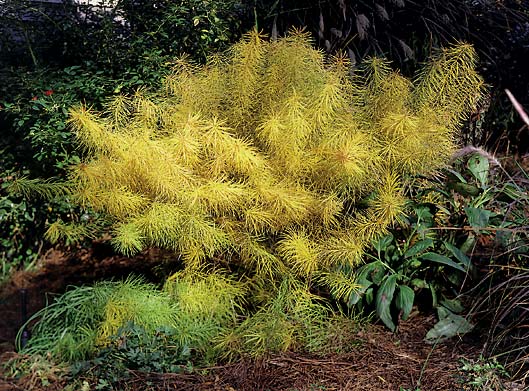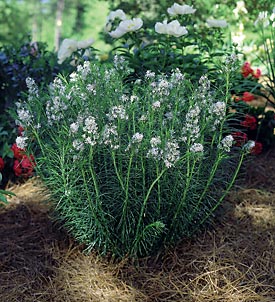 Photos by Wayside Gardens / www.waysidegardens.com
Photos by Wayside Gardens / www.waysidegardens.com
Amsonia hubrechtii Amsonia hubrechtiiby George Papadelis
Amsonia hubrechtiiby George Papadelis
September is too often considered a challenging month for perennial gardeners. Many of us believe mums are the only annual or perennial that provides interest in the fall. Nothing could be further from the truth. In sunny areas, try perennials like Sedum ‘Autumn Joy,’ hardy plumbago (Ceratostigma), boltonia, asters, blue mist spirea (Caryopteris), and ornamental grasses, just to name a few. In shady spots, try anemones, toad lilies (Tricyrtis), yellow wax bells (Kirengeshoma), hosta plantaginea, and fall-blooming crocus. And don’t forget about pansies. They are getting easier to find in the fall, and if planted then, they can bloom until Christmas or longer. Amsonia is yet another one of these late season performers whose color and durability make it a must for the fall garden.
Amsonia is rarely referred to by its common name “blue star.” Unlike most perennials, this one exhibits striking fall color that is more typical of many trees and shrubs. By late September, amsonia’s tight mound of olive-green, willow-like foliage takes on a brilliant yellow-gold color. This blends beautifully with other fall color, whether from mums or shrubs. Even before the fall show develops, these rounded mounds of fine foliage provide handsome forms and textures in the summer garden. Flowers too? Yes! In the spring, amsonia is covered with small, pale blue, star-shaped flowers, from which the common name is derived. Like many perennials, these only last a few weeks. It is the foliage of this plant which deserves recognition and more frequent use in the garden.
 Amsonia tabernaemontanaAmsonia has one other rare quality. This eastern U.S. native thrives in heavy, moist soil. “Heavy, moist” means clay and many of us have plenty of it. Use organic soil amendments like compost and peat moss when planting, but some clay will make amsonia feel right at home. Blue star is also long-lived, so dividing or replacing it will rarely be necessary. Position the plant in sun or partial sun and let time do the rest. After one year in the garden, you have plants large enough to draw attention. Keep in mind amsonia’s broken stems release a milky sap that may cause skin irritation.
Amsonia tabernaemontanaAmsonia has one other rare quality. This eastern U.S. native thrives in heavy, moist soil. “Heavy, moist” means clay and many of us have plenty of it. Use organic soil amendments like compost and peat moss when planting, but some clay will make amsonia feel right at home. Blue star is also long-lived, so dividing or replacing it will rarely be necessary. Position the plant in sun or partial sun and let time do the rest. After one year in the garden, you have plants large enough to draw attention. Keep in mind amsonia’s broken stems release a milky sap that may cause skin irritation.
Two types of amsonia are readily available and vary only in leaf form. Willow leaf amsonia or blue star (Amsonia tabernaemontana) has wider leaves resembling those of a willow tree, while Arkansas blue star (Amsonia hubrichtii) has very narrow leaves. Naturally, the latter species produces foliage effects that are finer and lighter in texture. Both types grow 2 to 3 feet tall and have great fall color.
If big, bright flowers are all you need in your fall garden, mums are probably your best bet. On the other hand, amsonia provides tidy mounds of beautifully textured foliage followed by outstanding fall color for years and years. Try it with some of the previously mentioned fall performers for a late season show you’re sure to enjoy.
George Papadelis is the owner of Telly’s Greenhouse in Troy.
At a glance: Amsonia
Pronunciation: am-SO-nee-ah
Common name: Blue star
Plant type: Perennial
Plant size: 24-36” tall, 36” wide
Flower color: Pale blue, star-shaped
Flower size: 1” across
Bloom period: Late spring to early summer
Leaves: Green; 2-6” long; 1/2-1” wide or very fine, depending on variety
Light: Full to part sun
Soil: Only moderately fertile, moist soil; prefers some clay content; if soil is too fertile, plant may tend to flop
Uses: Perennial border; use for its foliage texture, especially in the fall.
Companion plants: Sedum ‘Autumn Joy,’ ornamental grasses, boltonia, Russian sage, asters, blue mist spirea
Remarks: Fantastic golden yellow fall color. Long-lived perennial; frequent division is not necessary.
